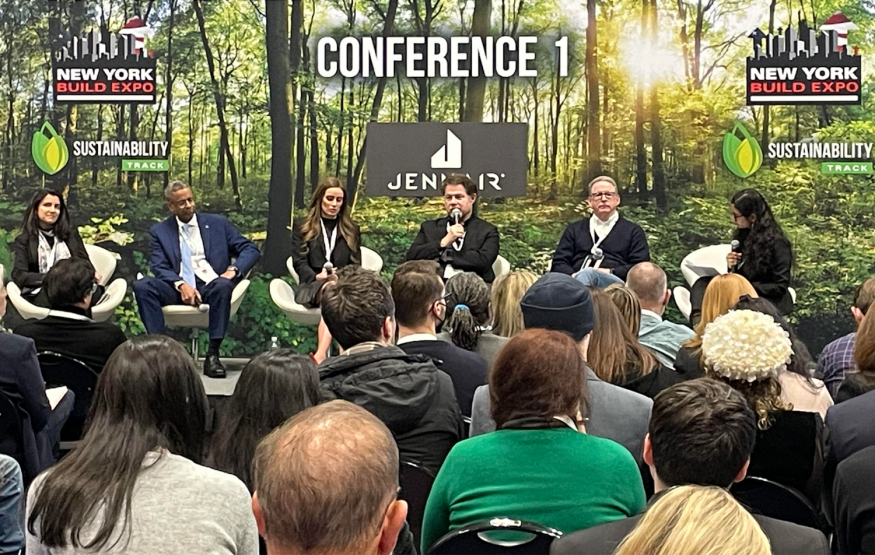
Crafting urban spaces that harmoniously integrate technical efficiency with vibrant social dimensions is a delicate art. It requires a deep understanding of the complex, interconnected systems that make up a city, where every design decision impacts both the physical infrastructure and the people it serves. It's not just about ensuring environmental resilience; it's about creating cities that are livable, equitable, and resilient.
Enter Ankita Nalavade, a master urban designer who has dedicated her career to perfecting the art of holistic sustainability. With a Master's degree in Sustainable Environmental Systems from the Pratt Institute, Ankita brings a unique blend of architecture and sustainability expertise to the table. Her education in systems thinking has equipped her to see cities not as disparate parts but as living organisms that require a holistic approach to design.
Ankita's architectural roots run deep, and her journey from designing individual buildings to influencing large-scale urban design is a testament to her commitment to technical innovation and social responsibility. "I started my career as an architect," she recalls, underscoring how her early days as a designer laid the groundwork for her current endeavors in the public infrastructure domain. Her unique work spans various sectors, from education to public policy, demonstrating her passion for improving urban quality of life through sustainable practices.
Architecture Meets Sustainability
Ankita's background in architecture laid the foundation for her holistic approach to urban sustainability, where she learned to question norms and apply the "Who, What, and Why" framework to every project. This people-centric mindset transitioned seamlessly into her urban design work, where she applied systems thinking to ensure that any new addition to the urban environment positively contributed to interconnected systems.
"In an urban environment, everything works in a system and is connected," she explains, emphasizing how changes can have far-reaching repercussions. Her graduate capstone project, focusing on a network of Urban Field Stations in New York City, exemplified how integrating technical aspects with social awareness can inform sustainable urban improvements. By collecting environmental data and fostering citizen engagement, she demonstrated how informed urban projects can mitigate the negative repercussions of human activities on surrounding ecology.
In her role at the NYC Department of Design and Construction, Ankita continued to prioritize community engagement, ensuring that green infrastructure projects, such as rain gardens, were not just functional but also appreciated and understood by the local population. Her commitment to education extended to her work at the Gowanus Canal Conservancy, where she developed a STEM curriculum to instill an early understanding of sustainability in middle and high school students, emphasizing the importance of green infrastructure in urban settings.
Tech and Community Unite
Effectively merging technical sustainability measures with community engagement, Ankita addressed environmental justice in New York City. As a fellow with the NYC Environmental Justice Alliance, she partnered with the nonprofit El Puente to develop a hyper-local community air quality program, empowering residents to collect and monitor air quality data. "Community members collected air quality data at regular intervals over two years," she explains, which helped identify that local facilities and expressways were significant polluters, and PM2.5 concentrations were up to 20 times higher than state monitors.
In her work on the East Side Coastal Resiliency (ESCR) Project, Ankita ensured that technical measures were also mindful of community impact. Recognizing the air quality concerns from transporting large amounts of soil, she recommended the use of barges instead of trucks; this decision helped to take trucks off the roads, which not only saved congestion over time but also protected the neighborhood and environment. This thoughtful integration of sustainability measures demonstrated how technical solutions, when combined with community awareness, can lead to more resilient and equitable urban environments.

Sustainability vs. Urban Growth
Balancing sustainability with the demands of urban growth is a complex challenge, especially in a densely populated city like New York. Ankita emphasizes that one of the toughest aspects is reducing greenhouse gas emissions while supporting a growing population. "The increase in urban population is directly proportional to the increase in energy use," she explains, underscoring the need for renewable energy solutions like solar PV panel systems and green roofs to manage energy consumption. The Port Authority of NY/NJ's initiative to install solar panels at Newark Liberty Airport, JFK Airport, and other facilities exemplifies this approach, showing how renewable energy can support expanding urban infrastructure.
Addressing the challenge of aging infrastructure, Ankita highlights that many existing systems, such as century-old water mains, were never designed to handle today's population. To combat this, she developed strategies in the NYC EDC's Clean and Circular Design and Construction Guidelines, advocating for deconstruction rather than demolition to reduce embodied carbon. "New infrastructure projects should rely on deconstruction as opposed to traditional demolition," she notes, pointing out that this not only promotes material reuse but also reduces carbon emissions. However, she acknowledges that finding storage for reclaimed materials and sourcing low-carbon alternatives remains a significant challenge, indicating that achieving true sustainability requires ongoing coordination and innovation.
Standards for All
Focusing on ensuring that all end users are considered, especially as technology evolves, Ankita's approach to creating inclusive standards for urban resilience is both comprehensive and adaptable. While working on retrofitting parking lots to accommodate EV charger infrastructure, she recognizes that the technology is very new and there is limited guidance in making it ADA-compliant. This makes it crucial to write standards that not only address current needs but also anticipate future advancements, ensuring that urban infrastructure remains adaptable and accessible.
By prioritizing standards that are both technically sound and socially inclusive, Ankita aims to create guidelines that stay relevant over time without hindering future technological developments. "Standards should not preclude future technology but at the same time use resources and materials wisely," she emphasizes, highlighting her commitment to a holistic approach that balances innovation with practicality in fostering urban resilience.
The Community's Voice Matters
Believing that community engagement is crucial for achieving truly sustainable urban environments, Ankita emphasizes that local residents possess invaluable knowledge about what works best in their neighborhoods. "It is important to reach out to them and integrate their input back into the design of the project," she notes, emphasizing that urban projects should be developed with the community's comfort and needs in mind to improve their quality of life genuinely.
In her role as Project Director for the East Midtown Greenway (EMG) project, Ankita ensured that community involvement was a priority throughout the process. Regular community board meetings, quarterly newsletters, and advance notices about closures kept residents informed and involved. "My team and I even worked with the community members to accommodate their programming activities safely during construction," she shares, highlighting how this inclusive approach fostered trust and appreciation. By organizing hard hat tours, Ankita enabled residents to experience the construction process firsthand, which contributed to the project's success and strengthened its positive impact within the community.

Adapting Green Guidelines
To ensure that sustainability guidelines remain adaptable to evolving environmental and urban needs, Ankita draws inspiration from the principles of Kate Raworth's Doughnut Economics. She emphasizes the importance of staying within the limits of our planetary boundaries, balancing economic productivity with environmental sustainability. This approach shapes her work in developing standards that not only reduce dependency on fossil fuels but also address overall energy consumption and greenhouse gas emissions, aiming to create policies that support this ideology of sustainable growth.
Ankita also underscores the need for guidelines to remain relevant amidst rapid technological advancements. She advocates for setting performance standards that provide strategic goals and best practices rather than rigid methods that could quickly become outdated. "The bio-solar system," she suggests, is one example of how combining solar panels with green roofs can maximize energy efficiency by generating power while reducing energy consumption through building insulation. By focusing on adaptable strategies, Ankita ensures that sustainability guidelines can evolve with the changing needs of urban environments and emerging green technologies.
Cutting Carbon Footprints
Promoting embodied carbon reduction in urban infrastructure presents several challenges, particularly regarding the storage and reuse of building materials. "After a building or infrastructure is deconstructed, the recovered material needs storage space," Ankita explains, noting that finding long-term storage in cities can be both difficult and expensive. Transporting materials in and out of the city for reuse further adds to greenhouse gas emissions and costs, making the process economically impractical.
Despite these hurdles, Ankita sees opportunities in initiatives like the Port Authority of New York and New Jersey's (PANYNJ) construction waste matching tool program. This marketplace facilitates connections between projects supplying and requesting construction materials, helping reduce GHG emissions by promoting the reuse of high-impact materials like concrete, asphalt, and soil. While organizations like BIG Reuse are making strides on a smaller scale, Ankita emphasizes the need for more coordinated efforts, as well as databases that can efficiently connect projects in real time, ensuring that material reuse becomes a practical and scalable solution in tackling embodied carbon.
The Future of Urban Sustainability
Looking ahead, Ankita is excited about the evolving landscape of urban sustainability, particularly the integration of technology and stakeholder collaboration to achieve ambitious goals. As part of the Port Authority of New York and New Jersey's (PANYNJ) Net Zero Roadmap, she is focused on addressing the complexities of Scope 1 and 2 emissions, which include direct emissions from the authority's assets.
"The most challenging emission to measure as well as to manage and lower are the scope three emissions," she notes, emphasizing that this will require advancements in technology and coordinated efforts across stakeholders. For instance, achieving a fully electric rental car fleet would necessitate collaboration between asset owners and rental companies, showcasing the importance of stakeholder outreach in meeting sustainability targets.
Ankita is also closely following advancements in carbon capture technologies, which she believes will play a pivotal role in mitigating already-released greenhouse gasses. She highlights innovative efforts by companies like CarbonQuest, which capture CO2 from high-traffic buildings and partner with CarbonCure technology to inject this CO2 into concrete. This process not only helps capture carbon but also reduces the carbon footprint of the concrete, demonstrating a promising strategy for reducing emissions while repurposing them for sustainable construction practices.
Ankita's journey in urban sustainability showcases a powerful blend of technical expertise and community engagement, demonstrating how integrating scientific and social strategies can transform urban design. Her work emphasizes the balance between environmental integrity, social responsibility, and economic viability, reshaping urban spaces with a focus on involving local communities in decision-making. As she continues to advance sustainability standards that incorporate emerging technologies and community perspectives, Ankita represents a future where urban design is both technically robust and socially inclusive, achieving harmony between development and ecological stewardship.
© 2026 ScienceTimes.com All rights reserved. Do not reproduce without permission. The window to the world of Science Times.










